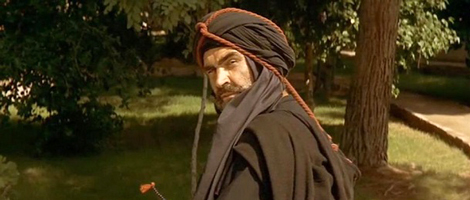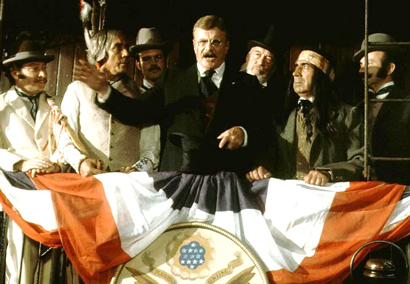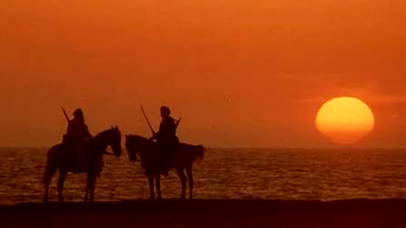Reviewed by Glenn Erickson
This big, rollicking adventure story is John Milius' best movie by far. He can be a good storyteller with historical material, and here has great fun with Teddy Roosevelt's Big Stick and the competition between the Big International Powers. Liberally adapted from a true incident, The Wind and the Lion is a throwback to a pre-conscious era of colonial adventure stories, with Sean Connery and Candice Bergen making a spirited semi-romantic pairing. Despite some sillier passages Milius' show is packed with honorable action and glorious, old-fashioned derring-do. It has a strong nostalgic charge for fantasies made obsolete by a better awareness of history. Milius quite seriously describes himself as a neo-imperialist, but he's perfectly happy with the political contradictions in his simultaneously pro- and anti- imperialist tale.
The movie takes place in 1905, in the poor country of Morocco, which is partly occupied by Spain and contested by several other European nations. U.S. warships are in the harbor as well. Barbary Pirate The Raisuli (Sean Connery) kidnaps American citizen Eden Pedecaris (Candice Bergen) and her two children to embarrass the rulers of his country, craven sell-outs to the European powers. The kidnapping naturally puts the Americans on alert. The popularity of President Theodore Roosevelt (Brian Keith) skyrockets when he promises to retrieve the hostages. Acting on their own, the American Marines find an expeditious way to alleviate the problem: seize the Moroccan government!
The Wind and the Lion was not the right movie for 1975. Just a couple of years after Watergate, the country was sick of Vietnam and in a big hurry to forget political realities. Retro history buff and he-man adventure screenwriter John Milius celebrates imperialism with the same audaciousness shown by his brash Marines, but he also reserves a great affection for the rebel underdog. The movie really has no liberal perspective. Gunboat diplomats cheerfully battle equally cheerful fundamentalist Muslim rebels, with only pompous Europeans and decadent Moroccans in between. 1

What saves John Milius from pretension or historical humbuggery is his essential honesty. The Wind and the Lion is his personal take on Victorian imperialism. It's basically an action spectacular, and it frequently verges on adolescent silliness. Yet it's not some poorly researched screed.
The film's portrayal of 1905 attitudes is refreshingly out of sync with liberal1975, when American history was being revised to stress culpability in the genocide of Native Americans, etc. Milius' affectionate portrait of Teddy Roosevelt, (played beautifully by Brian Keith) stresses all the he-man qualities of the President's public image. Roosevelt was of course an aggressive imperialist but he also fought tooth and nail against the robber barons of American big business. In this film, Teddy is shown ignoring his opportunistic advisors, who immediately think of annexing Morocco as an American puppet state.
The Wind and the Lion's Raisuli is fabricated with great respect. Connery's brigand may have a Scots brogue now and then, but the character's heart is in the right place. The Raisuli is a fanciful Kipling-like creation, a holy warrior who bows to Mecca and gleefully executes men for trivial offenses. Of course, by comparison with his royal relations The Raisuli is a prince. The spoiled brat Sultan and the elitist Bashaw live in outrageous luxury under a system that hasn't changed in centuries.
To some degree Connery and Candice Bergen are playing kids' dress-up in the desert. Bergen is a good fit for a patrician Yankee, and Connery must wield all of his star authority to prevent The Raisuli from becoming a major joke. The actor performs the part with a slight comic streak, perhaps to ensure that the audience laughs with him instead of at him.
Yet the film's romantic chemistry works on at least one level, bringing to life old clichés thought to have died with Rudolf Valentino. The desert kidnapping is a throwback to the silent The Sheik, except the seduction here is never consummated. Connery struggles with trying to be a Berber, but Bergen surprises us with a wonderfully spunky nobility, matching Connery's quips with expert precision and riding as well as anyone on screen. She reins in her horse while cursing her captor's name to God, something your average clotheshorse actress probably couldn't handle. Better yet, when some of the action situations put a serious strain on credibility, Bergen's screen authority saves the day.

Not all that expensive a movie, Milius' film makes maximum use of limited means, achieving some of the grandeur of 1950s and '60s epics with a fraction of the cash outlay. Almeria, Sevilla and Madrid locations provide lavish palaces, castles, and towns. Even the sets representing Washington and the Rocky Mountains aren't bad. We'd been seeing Spain in countless Spaghetti Westerns and Ray Harryhausen movies, but it never looked better here. The production uses locations recognizable from Spartacus (the big valley with the gladiator camp on the hill) and a unique castle from El Cid. Southern Spain has so much Moorish architecture, it stands-in well for Morocco.
Much of the direction is classic and simple. Milius had the wisdom to allow his expert cameraman to organize most of the shots to a plan instead of inventing on the set. He also enjoyed a good relationship with his key second unit directors, especially stunt arranger Terry Leonard. Easily half of the shooting schedule was used for the spectacular battles and action scenes. They're a cross between David Lean and Sam Peckinpah -- pictorially handsome, geared for maximum thrills.
The action is violent fun. Most of the combatants are professional soldiers of one kind or another and thus predisposed to fight. Our loyalties go all over the place over the course of the film. The Raisuli's pirates begin as murderous scum but by the end we're applauding the nobility of an Arab charge. Connery's superhuman rescue of Bergen and her children is pure escapist fantasy, told in epic fairy tale terms. Milius seems to like all of the military factions in the movie, even the Kaiser's Germans.
The key scene is a shockingly blunt military action when the Marines under Captain Jerome (Steve Kanaly) seize the Bashaw's palace. This military solution to stalled negotiations is an excellent focus for discussion. Captain Jerome's brutal stunt works like a charm, making heroes of his fighting men while freeing Roosevelt from his predicament with politically advantageous expediency. Milius shows a takeover of a foreign government exactly the way it might have happened a hundred years ago: the U.S. troops wipe out every combatant they encounter, run up the flag and call it a day. The rescue mission is less a goal unto itself than a means to a political end. Milius' movie celebrates the 'glory' while showing the 'naked aggression' aspect as well. This kind of thing has been going on forever -- the movie opens our eyes.

I once saw the original 40-page treatment for The Wind and the Lion at UCLA. It's full of descriptions of rooms and an elaborate Moorish bath given the Pedicaris character. It read beautifully. Most of the exoticism in the finished film is dropped in favor of adventure elements. The Boy's Own theme is present in the repeated use of young William Pedicaris' point of view, which fuses well with Jerry Goldsmith's exultant, sweeping score.
The Wind and the Lion klunks only in a handful of moments, as when we're supposed to believe that young William helps his mother escape by hitting a guard over the head with a potted plant. Scoffers point out Connery's accent, but hiring the actor is no mistake -- who else could play such a bigger-than-life hero? The production does get a bit thin in its last third. We arrive at the Raisuli's castle but never see an interior, only little gatherings on the doorstep. So much for all those descriptions of baths and rooms suitable for a hareem.
Milius' writing skills are tested by the period dialogue, which by the end has worn thin, or perhaps has been replaced with on-set inspirations. The Connery-Bergen romance develops from shouting to teasing to mutual honesty, but then advances no further. Before their glorious parting they share rather dumb dialogue, when the relationship needed to leap to some new level. Then there are the silly 'cute' dialogue lines that sneak in, apparently to maintain a light tone. A magnificent ride-out from the castle under a gathering storm is capped with a leaden klunk when The Raisuli says "I'm the Raisuli, they do the singing!" That's soon followed by the all-time idiotic rejoinder:
Raisuli: "It is good!"
Sherif: "What is good?"
Raisuli: "It is good to know where we are going!"
Eden Pedecaris' single-handed hijacking of the Marines is another bad idea that always makes audiences laugh. We like the idea that the Marines might volunteer to help her rescue The Raisuli, but having Eden get Captain Jerome's attention by threatening him with a knife is ... well, it just shows that John Milius can't conceive of personal interaction without the involvement of some form of weaponry. The movie crosses into outright infantilism for a few moments.
Milius is one of the 1970s generation of directors back-grounded in film school instead of the stage or old Hollywood. Thus the movie borrows liberally from fave pictures, even though Milius only admits the obvious similarities to Lawrence of Arabia. When 'The Ugly Arab' Aldo Sambrell entices Jennifer Pedicaris from a cave-like arch, it's a quote from The Searchers, a definite touchstone film for this group. Milius more crudely borrows the machine-gun test and the 'march' from The Wild Bunch. The great production team here gives The Wind and the Lion epic qualities that absorb the film-fan idolatry and rough moments. To be kind, the director's later efforts Big Wednesday, Conan the Barbarian and Red Dawn show him to be much more of a writer than a director.

But Milius' bolder strokes are inspired. The title epigram -- the Raisuli is like a lion that must stay in its place, while the great Roosevelt is like the wind that will never know its place -- is a poetic description of the American search for identity. The theme informs some of the best genre work, especially Sam Peckinpah's Major Dundee. Under its indulgent adventurism and occasional lapses into cuteness, The Wind and the Lion really is about something.
The Warner Archive Collection Blu-ray of The Wind and the Lion gives John Milius' epic the visual boost it needs. The added detail of HD helps out in all of those large-scale shots of marching soldiers and charging horses. The clean transfer appears to have less grain as well. The disc takes me back to Hollywood Blvd. in 1975, seeing the movie in a 70mm blowup. The print here is the first release version, retaining a shot of some severed heads cut from the general release.
The commentary: "Notice all the gun stuff is very realistic in my movies."

The extras come direct from the first (2003) DVD release. Director Milius misidentifies Vladek Sheybal (From Russia With Love, Kanal) as Antoine St. John (Duck You Sucker), but he does so in an isolated sound bite that may have been incorrectly placed by the commentary editor. His remarks are often informative -- the Indians on the train platform with Teddy during his barnstorming speech are supposed to be Quanah Parker and Geronimo, for instance. Milius is typically charmed by his own cleverness and repeats a lot of his dialogue. Naturally, we hear about how he surfed between takes on the Almerian beaches, and no gun is shown without being identified and its role in the film explained in full detail. Milius' cameo? A one-armed arms merchant. 2
The original featurette intercuts clips with excellent behind-the-scenes material. Sean Connery and Candice Bergen are on screen for one bite apiece, describing their director on his sophomore outing. Connery kids Milius for 'doing the Hemingway bit', but everyone pegs the director as creative and talented. The effects men are shown rigging explosions for a horse charge, but only stunt horses are seen in action, not the scores of 'tripped and tricked' horses tumbling like tenpins.
Milius' commentary is interestingly silent during these exciting but obviously murderous scenes. "We never hurt a horse on this movie. Would never do that," says Milius. The Wind and the Lion is considered a film maudit by animal rights activists, a title proving that the systematic abuse of horses in movies was still happening. 'Running W's' and other tripwires were once a common practice in old Hollywood, and Milius' picture bore the brunt of the scorn for continuing the cruelty.
The original trailer shows the unaltered shot of the Marines marching on the Moroccan dock, before Matthew Yuricich's matte painting added the ships of the Atlantic squadron ships to the harbor.
The end credits list Luis Barboo as Gayaan The Terrible. The Raisuli tells the story of his battle with Gayaan, but if the fight itself was shown in a flashback, it must have been cut out at the last minute. Milius doesn't mention the missing scene. This places poor Señor Barboo in the same company as Nigel Green. Green's name appears boldly in the credits for Mysterious Island, but he's absent as well.
On a scale of Excellent, Good, Fair, and Poor,
Blu-rayThe Wind and the Lion rates:
Movie: Very Good ++
Video: Excellent
Sound: Excellent
Supplements: Commentary with John Milius, original featurette
Deaf and Hearing Impaired Friendly?
YES; Subtitles: English
Packaging: Keep case
Reviewed: May 4, 2014
Footnotes:
1. Interestingly, the week of The Wind and the Lion's release, Time magazine displayed a cover with a jingoistic action comic-book image of Marines landing in Southeast Asia during the Mayaguez Incident. Photos inside showed President Ford reacting to positive news of the rescue, just as if a touchdown had just been scored in the Super Bowl. After the depressing TV shots of helicopters evacuating Saigon, and the crash of a jet packed with Vietnamese orphans, the editors must have thought America needed upbeat, Wind and the Lion -- like military action to lift spirits.
Return
2. Savant worked for almost two years on Milius' production of 1941 and spent some time with the director talking about The Wind and the Lion and Apocalypse Now, which hadn't yet been released. Milius told me that the real Raisuli was a Geronimo-like holdout that was eventually caught and executed by the Bashaw and Sultan. Milius also related a suspiciously exciting account of his capture. According to Milius, when the Raisuli realized he was too old to continue fighting, he made peace with his enemies. He invited them to a banquet, which he then dynamited! When the old man was rounded up not long thereafter, he had no property and hardly any followers to speak of.
Milius was a jolly-enough guy but a political hothead. He flew into a rage when President Carter announced his plan to give the Panama Canal back to the Panamanians. Milius could also be friendly. He gave Candice Bergen's pump shotgun to Spielberg during the filming. I was given the job of taking it out and getting it cleaned (the action had seized up). It was fun to play with it, a real 1897 Winchester. Guns are really cool until one contemplates what they do to people.
Return
A Note from Savant correspondent "B" aka 'woggly', 1/8/04: Hi Glenn. This wasn't road-shown -- that was all over by 1975 -- but Metro and UA did a great job marketing the movie, with beautiful 70mm stereo Metrocolor prints in its key exclusive engagements. I'm not sure what was done in L.A. but in NY the studio set the picture up as its newest classic in a splashy way. Radio City Music Hall ran week-long engagements of Gone With the Wind, 2001 and Singin' in the Rain immediately prior to the opening of Lion at the Great Hall. It is possible they also ran a week of Doctor Zhivago; I can't recall. This may explain in part why the trailer references GWTW and Zhivago. A terrific, classy campaign. I wish Allied Artists had made even half so elaborate and ambitious a marketing effort in support of its Christmas '75 The Man Who Would Be King. Lazily, AA actually used the same font as Lion's on its King one-sheet. I wouldn't get excited about the historical accuracy of Lion, but it makes for a rousing show. I still remain hopeful that Milius will one day make another entertaining picture like this one.
But I would remind you that the Ford administration actually embraced The Wind and the Lion. A key presidential aide crowed, "I think we've found our Patton!" It was screened at the White House. President Ford, impressed by the National Park sequences with TR, fondly recalled his days as a youth working at Yosemite. I don't know whether anyone from MGM was brave enough to tell him that those scenes were shot in Spain. Best, Always. -- B.

Text © Copyright 2014 Glenn Erickson
See more exclusive reviews on the Savant Main Page.
Reviews on the Savant main site have additional credits information and are often updated and annotated with reader input and graphics.
T'was Ever Thus.
Return to Top of Page
|


